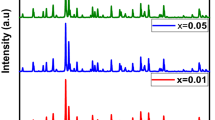Abstract
An approach is proposed for fabricating fine-grained, low-resistivity BaTiO3-based PTCR ceramics via partial isovalent substitutions on the Ba site. The grain size of the ceramics thus prepared is shown to decrease as the ratio of ionic radii r(Ba2+)/r(M2+) (M = Ca, Sr, Pb) increases. Isovalent substitutions on the Ba site narrow down the range of donor dopant (yttrium) concentrations in which PTCR materials can be prepared. The experimental results agree well with thermodynamic calculations under the assumption that the materials contain the Y3+Ti3+O3 phase, as suggested by ESR data, which point to the presence of Y3+–Ti3+ associates. Partial calcium, strontium, and lead substitutions on the Ba site reduce the average grain size of PTCR ceramics, which is probably due to the lattice strain arising from the isovalent substitution. Partial replacement of Ba2+ with mixtures of different isovalent elements (e.g., Sr2+ and Pb2+) offers the possibility of obtaining fine-grained, low-resistivity PTCR ceramics, without changing the phase transition temperature.
Similar content being viewed by others
REFERENCES
Prokopalo, O.I., Gol'tsov, Yu.I., Filip'ev, V.S., et al., Classification of Modification Additions to Barium Titanate, Izv. Akad. Nauk SSSR, Ser. Fiz., 1969, vol. 33, no. 7, pp. 1157–1160.
Belous, A.G., V'yunov, O.I., Khomenko, B.S., and Yanchevskii, O.Z., Microstructure and Semiconducting Properties of Barium Titanate Containing Heterovalent Substituents on the Titanium Site, Neorg. Mater., 1998, vol. 34, no. 6, pp. 725–729 [Inorg. Mater. (Engl. Transl.), vol. 34, no. 6, pp. 597–601].
Xue, L.A., Chen, Y., and Brook, R.J., The Influence of Ionic Radii on the Incorporation of Trivalent Dopants into BaTiO3, Mater. Sci Eng., B, 1988, vol. 1, pp. 193–201.
Koschek, G. and Kubalek, E., Grain-Boundary Characteristics and Their Influence on the Electrical Resistance of Barium Titanate Ceramics, J. Am. Ceram. Soc., 1985, vol. 68, no. 11, pp. 582–586.
Belous, A.G., Yanchevskii, O.Z., V'yunov, O.I., and Kovalenko, L.L., Synthesis and Properties of (Ba1_ x _ ySryYx)TiO3 Ferroelectric Semiconductors, Ukr. Khim. Zh. (Ukr. Ed.), 1998, vol. 64, no. 11, pp. 3–7.
Kuwabara, M. and Kumamoto, K., PTCR Characteristics in Barium Titanate Ceramics with Curie Points between 60 and 360°C, J. Am. Ceram. Soc., 1983, vol. 66, no. 11, pp. 214–215.
Blanchart, P., Balertrieri, D., Weber, F., and Abelard, P., Influence of Calcium Addition on the Microstructure and the Electrical Properties at Room Temperature of BaTiO3 for PTC Thermistors, Silic. Ind., 1994, vol. 49, no. 1/2, pp. 47–52.
Venevtsev, Yu.N., Politova, E.D., and Ivanov, S.A., Segneto-i antisegnetoelektriki semeistva titanata bariya (Ferro-and Antiferroelectrics of the Barium Titanate Family), Moscow: Khimiya, 1985.
Belous, A.G., V'yunov, O.I., Yanchevskii, O.Z., and Kovalenko, L.L., Thermodynamic and Experimental Investigation of the Effect of Rare-Earth Ions (Ln3+) Nature on the Posistor Properties of (Ba1_ x Ln 3+ x )TiO3, Key Eng. Mater., 1997, vols. 132–136, part 1, pp. 1313–1316.
Kornienko, S.M., Bykov, I.P., Bykov, M.P., et al., Impurity Centers in Rare-Earth-Doped Barium Titanate Ceramics, Fiz. Tverd. Tela (S.-Peterburg), 1999, vol. 41, no. 10, p. 1838.
Poluprovodniki na osnove titanata bariya (Barium Titanate Semiconductors), Okazaki, M., Ed., Moscow: Energoizdat, 1982, pp. 33–37 (translated from Japanese).
Becker, R., Uber der aufbau binarer Ligierungen, Z. Metallkd., 1987, vol. 29, no. 8, pp. 245–250.
Urusov, V.S., Teoriya izomorfnoi smesimosti (Theory of Isomorphous Miscibility), Moscow: Nauka.
Glinchuk, M.D., Bykov, I.P., Kornienko, S.M., et al., Influence of Impurities on the Properties of Rare-Earth-Doped Barium-Titanate Ceramics, J. Mater. Chem., 2000, vol. 10, no. 4, pp. 941–947.
Nagao, F., Jpn. Patent 47–41153, Byull. Izobret., 1972, no. 10.
Author information
Authors and Affiliations
Rights and permissions
About this article
Cite this article
Belous, A.G., V'yunov, O.I., Kovalenko, L.L. et al. Effect of Isovalent Ba-Site Substitutions on the Properties of (Ba1 – x – y M y Y x )TiO3(M = Ca, Sr, Pb) PTCR Ceramics. Inorganic Materials 39, 133–138 (2003). https://doi.org/10.1023/A:1022142528744
Issue Date:
DOI: https://doi.org/10.1023/A:1022142528744




